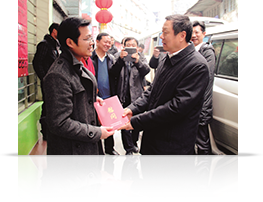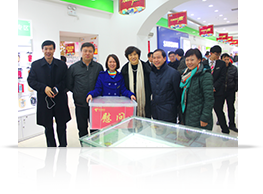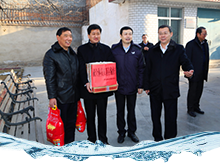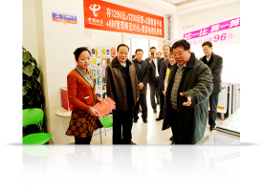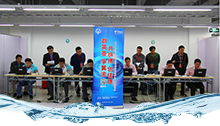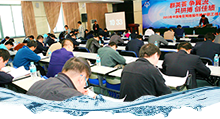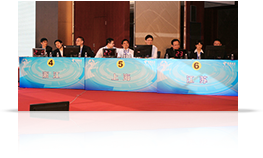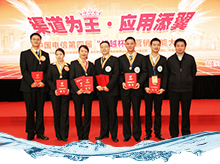Human Resources Development Report
In 2013, in accordance with the overall strategy of “De-telecom”, “Market-orientation and Differentiation” and “Three New Roles”, we firmly adhered to the principle of “supporting development and serving our employees”, and grasped the overall idea of laying down a strong foundation of team building and constructing a mechanism for promoting further development. Leveraging on the human resources planning, the Company further enhanced its building of teams of management, professional technicians and innovative talents and increased its efforts in mechanism innovation for human resources management, which have pragmatically protected the rights of its employees and effectively supported its business development.


Firstly, the Company built a value-based human resource planning system. Modelled on the supply value chain concept, a value model of China Telecom human resources was built to include key performance indicators for enhancing the value of its human resources management, and to establish strategic, operating and supporting systems for human resources management. As such, the Company has formulated the key performance indicators, major tasks and key measures in relation to human resources management from 2013 to 2016, which have effectively improved the vision and rationality of the human resources management of the Company.
Secondly, the Company improved the management of our executives and strengthened our senior management team building. The Company initiated a consolidated performance assessment for management in a move to enhance the appraisal system. The enhanced appraisal system further strengthened the use of the evaluation results in the selection, appointment and training of management personnel. We also sped up outstanding young leaders’ promotion and improved the selection and appointment process by promoting a total of 33 employees to leadership positions in a higher rank through the elections and open recruitment organised by the Company during the year, which further optimised the age mix of our management team. In addition, the Company pro-actively promoted a job exchange program among executives to enhance their leadership skills and all-round capabilities through a multi-job training. In 2013, 20 executives participated in the program.
Thirdly, the Company strengthened its efforts in building a team with innovative talents. To foster the building of a team with innovative talents, the Company created an incubation centre and introduced a creative management and operating system with a market-oriented approach, so as to create an incubation environment for new business development teams and an incubation system that would clear the way for their corporatisation. Over the last two years, the Company has separately selected 68 innovative projects in four batches for further development at the incubation centre. Under the promotion of this “professional incubation + entrepreneurial guidance + angel investment” incubation model, the Company has currently realised the corporatisation of 18 innovative projects, with the number of employees in the new business development teams reaching 276.
Fourthly, the Company promoted innovative human resources management to support our services development. We increased our efforts in developing pilot schemes for the transformation of our human resources management. Through the pilot schemes, the Company enhanced the efficiency of its human resources management through optimising the employee structure, controlling the total number of employees and creating a differentiated remuneration distribution mechanism. For the development of its emerging services, the Company has set up a program for gathering and nurturing talents for its emerging services while actively exploring the human resources management practices for the mobile Internet services.
Lastly, the Company actively implemented the new Labour Contract Law of the People’s Republic of China which regulated the use of labour force by enterprises. The Company carried out a comprehensive research on the new Labour Contract Law of the People’s Republic of China, set up guidelines for its service operation model, proposed structural adjustment to its personnel, put forward the principle of “equality of remuneration and work” and the standardisation of outsourcing arrangements. Based on the new Labour Contract Law of the People’s Republic of China, the Company proactively implemented the principle of “equality of remuneration and work” with self-regulation, which effectively limited the risks of the use of labour force by the Company.
-
Information of Employees
As at the end of 2013, the Group had 306,545 employees. The numbers of employees working under each classification and their respective proportions were as follows:
Number of
employeesPercentage Management, Finance and Administration 49,113 16.0% Sales and Marketing 157,915 51.5% Operations and Maintenance 97,264 31.7% Research and Development 2,253 0.8% Total 306,545 100% -
Corporate-Employee Relationship
Communication between Management and Employees
The Company established a feedback system to systematically understand and know the employees’ views as well as promoted a close-end management system to handle the requests and concerns of the employees. In 2013, the Company’s management and labour union leaders made over 60 visits to over 200 employees, including those who were in difficulty as well as the outstanding employees. To understand the views of the employees, the Company also introduced a third party survey involving over 7,000 employees in eight provincial branches to investigate their stress conditions as well as the sources and impacts of their work stress and the channels for relieving such stress. We have also timely understood and grasped the issues expressed by the employees, and actively reflected the demands of the employees by making proposals and recommendations to the Company.
Roles and Duties of Labour Unions
Our labour unions persisted in the principle of “serving both corporate development and the employees’ growth”.
We established an honours system for the employees. Based on the unified standard that adopted different layers and classifications and frontline-orientated incentive development principles, the Company researched and developed the “China Telecom Employees’ Honours System” which established a multi-level, comprehensive, guidanceoriented and sustainable honours system and brought about deepened incentives for the employees. The honours system, together with the position and remuneration system, formed a differentiated incentive mechanism.
We created a platform for the on-the-job innovation activities of employees. Based on a low entry barrier, wide coverage, easy to replicate and longterm incentive approach, the Company actively created a platform for the enhancement of the employees’ job innovation and capability, which further promoted the on-the-job innovation activities of the employees.
We created an ambience of innovation. The Company introduced an exemplary promotion convention in 2013 to award excellent quality and spirits. In 2013, two employees were awarded the “National May 1st Labour Award” while five received the “National May 1st Labour Medal”; 12 units were awarded the “National Pioneer Workers”; 14 units were awarded the “State-owned Pioneer Groups”, with 25 workers being awarded the “Outstanding Workers”; 50 units were awarded the “Enterprise Pioneer Groups”, with 97 workers being awarded as “Outstanding Workers”; nine employees were named as “Technical Master of China’s State-owned Enterprises” while 24 were named as “Technical Master of Enterprise”. To promote exemplary pioneer workers on a regular basis, the Company increased the intensity in the promotion of more than 80 frontline outstanding employees and over 10 teams. The Company actively created an ambience of advocating, learning, competing and caring for these pioneers in order to incentivise its employees to continue to pursue excellence.
The Company also offered guidance to the labour dispatch entities and labour outsourcing entities for them to establish labour unions and their employees to join the unions, in order to motivate employees’ passion to participate in and support corporate development. As such, the union enrollment rate of the employees has reached 97%. The Company actively developed activities to build home for the employees and 14 provincial labour unions were named as the “Home for National Outstanding Workers”.
Coordination and Communication between the Company and the Labour Unions
Over 700,000 counts of employees participated in three new business development competitions, which included network enhancement labour competition to improve network quality, a four-stage technical skills competition and the network security competition organised by the Ministry of Industry and Information Technology. The Company has also organised an on-the-job innovation training program for frontline employees, setting up a learning and exchange mechanism and promoting multi-level innovative workshops. To date, there were over 60 innovative workshops that aimed to speed up knowledge sharing and to transfer excellent experience and techniques. A win-win situation was attained for both the Company and the employees by enhancing the employees’ technical skills, business skills, practical experience and their passion for innovation.
Caring for Employees
We deepened the implementation of the “Four- Smalls” initiative. The Company included the operating cost of the “Four-Smalls” initiative into its budget management to enhance its operating efficiency. The area of coverage of the “Four-Smalls” initiative was extended to different frontline operating units such as sales outlets, “10000” call service, and the installation and maintenance teams such that 80% of the frontline units implemented “Four-Smalls” initiative and employees of these units managed to benefit from such initiative. In addition, more were added to the “Four-Smalls” initiative to target different employees in different zones and different situations so that their actual difficulties and problems can be tackled immediately. The Company also adopted several measures to alleviate the stress of its employees.
We established a regular mechanism for employee visits. During the New Year and Lunar New Year holidays, the Company’s entire management team visited frontline units in 17 provinces (districts and prefecture-level cities) to show their care for the employees. The management of the Company, labour union leaders and staff often found time to visit employees who were in difficulty as well as the outstanding employees when they were in their regions.
We cared for our employees in the affected regions and regions with severe conditions. The Company raised over RMB22 million for employees who were affected by the Ya’an Earthquake. In addition, a special relief fund of RMB1 million was allocated to the labour union in Sichuan province to assist the employees in the affected regions. RMB1.7 million was allocated to the affected employees in Gansu province as allowances for their families. The Company also allocated RMB12.1 million to frontline employees at 16 provincial branches as the “Cool Summer” subsidy. The Company also organised six sessions of study and field trip activities that promoted “Hand and hearts filling the love of China Telecom” for the employees that provided continued services during Ya’an Earthquake and an exchange program among the excellent employees working in areas with severe conditions. 186 outstanding employees participated in the activities.
We conducted activities to boost morale and team work. China Telecom organised a balloon volleyball tournament for its employees. China Telecom also took the trophy of the balloon volleyball competition organised by the China Telecommunications Sports Association. An internal photo competition organised by the Company attracted over 3,000 submissions which enriched the Company’s mobile photos archive. A national photography exhibition co-organised by the Company, the Popular Photography Magazine and the terminal company attracted over 60,000 entries, which successfully raised the branding of our “e-Surfing” service. Provincial labour unions organised over 50 arts and sports activities that not just enriched the employees’ cultural life, but also raised their morale and team spirits.
-
Strengthening Human Capital
Focusing on our strategic development priorities, the Company continued to strengthen the development of talent teams, and actively promoted the capabilities improvement of our operation managers, professionals and technical personnel.
Developing Leadership Skills
In 2013, we organised and launched four phases of leadership training sessions for the management from the headquarter and provincial branches, two phases of leadership training sessions for prefecturelevel management and a training session for the newly appointed management executives, with a total of 502 counts of managers attending the training sessions. The Company also actively sent management personnel to attend various trainings for high-level talents. In 2013, a total of five general managers from the provincial branches attended the leadership training organised by the China Executive Leadership Academy, Yan’an, and China Business Executives Academy, Dalian, while 10 deputy executives from the headquarter attended the elective sessions for senior management. To fully utilise the functions of China Telecom College, the Company provided training for the new executives with emphasis on leadership training. To leverage on the strength of the online university, the Company set up special learning zones for managers to learn about the new technologies and new businesses. The Company also actively explored the training model for the reserved management, initiating a pilot scheme known as “entrepreneurial training camp” which was used as a basis to stimulate new thoughts among the reserved management team.
Cultivating Professional Talents
To fully utilise the professional talents based on the Company’s corporate focus, the Company has developed an annual work plan for each group of professionals in order to nurture their talents. In 2013, the Company organised 11 training sessions for Rank B talents under seven categories, including sales and marketing, IP, IT, wireless and mobility, core network, optical transmission and access as well as platform, with a total of 699 counts of senior professionals attending the training and a coverage ratio of over 95%. During the period, the Company examined 385 Rank A and Rank B talents specialised in IP, IT/ICT and sales and marketing, of which 110 were awarded with distinction.
Enhancing Employees’ Skills
The Company actively commenced frontline employees’ skills training and skills certification. In 2013, in order to support the overall strategy of “De-telecom”, “Market-orientation and Differentiation” and “Three New Roles” the Company focused on the key business development areas and held 187 training sessions covering various areas, including marketing, products, sales services, corporate informatisation, maintenance and service support, network development and construction and integrated management, with 13,000 attendees in total, up 6.2% from 2012. The Company also organised and conducted skills certification for nine types of skills such as channel management, corporate informatisation, and customer service. A total of 82,000 counts of employees participated in the certification examinations. In line with the Group’s efforts to sub-divide performance evaluation units, the Company emphasised on the training provided for channel managers, secretaries of rural bureaus and self-managed TOP shop managers. In relation to our key businesses, the Company initiated trainings with an emphasis on relationship marketing of informatisation application in the industry and trainings to enhance supporting capabilities of key informatisation application. In addition, the Company also focused on the frontline employees and organised frontline training, as well as training on the mobile operating system and other professional training activities focusing on particular models. These training sessions fully enhanced the business techniques of frontline employees.
Looking forward, the Company is keen to build a team of talents and further enlarge the talent reserves for emerging services. In 2013, the Company recruited approximately 6,400 fresh graduates, 71.6% of which were majored in communications, computer engineering, sales and marketing and information operations management, up 11 percentage points from 2012. The Company continued to recruit top graduates for the available positions, with over 1,000 top graduates being selected in 2013, and a total of approximately 3,400 top graduates being trained in the past three years.
-
Remuneration and Performance Management
The remuneration of the Company’s employees comprises base salary and performance based salary, and takes into account both short and medium-to-long term incentives. In 2013, the Company implemented the “Position and Remuneration System of Full Services Operation”, instructing each business unit to gradually implement the system based on trial-run results. Furthermore, the Company persisted in determining the distribution of employees’ remuneration based on their value and contribution while tilting towards the core frontline employees. At the same time, to facilitate the introduction of sub-dividing the performance evaluation units, the Company introduced innovative distribution mechanisms to motivate and incentivise its employees. Through measures such as market mechanism, shop owner responsibility system and tender underwriting, the Company managed to delegate responsibilities, allocate key resources and run independently with consistent rights and responsibilities. These measures unified the interests of promoting corporate development and the individual interests of employees. By directly linking up the employees’ salary level with their performance evaluation results, the Company encouraged its employees to be more productive so that they could fully realise their individual value and achieve a higher remuneration level while working for the company.
To continuously improve the model for classification and allocation of labour costs, the Company adopted a flexible budget control policy for provincial branches which proportionately matches income with labour cost such that more allocations were made to units with a higher level of revenues and vice versa. The Company continued to enhance the correlation between revenue and labour costs in terms of labour cost allocation and raise the allocation ratio in accordance with profit-linked efficiency. Furthermore, the Company continued to apply reduction rules to the labour costs incurred by the provincial branches that failed to meet the profit budget amounts, which ensured that the labour cost allocation mechanism fitted well into business development of the Company. The Company also applied value deposition and development cycle to manage its direct subsidiaries and professional companies and implemented a differentiated model for classification and allocation of labour costs.
At present, China Telecom has established a relatively comprehensive employees’ performance evaluation system. Branches of all levels have established employees’ performance evaluation teams which are led by the respective general manager of the relevant branch. The teams have formulated evaluation methods for deputies, functional departments, subordinated units and general employees. In 2013, the Company managed to further improve its employee evaluation and incentive mechanism and related supervision system to secure the fairness and reliability of the performance evaluation results. At the same time, it has further optimised and improved the performance evaluation system to appraise the performance of business units, deputies, middle-level management and employees at different levels, enhancing the specific focus and relevance of the entire performance evaluation process.
Guaranteeing Employee Welfare
The Company strictly abides by the laws and regulations such as the “Labour Law of the People’s Republic of China” and the “Labour Contract Law of the People’s Republic of China” to regulate its employment practices. The Company offers equality of remuneration and work, implements special regulations to protect female employees’ rights and interests, and there were no gender discrimination policies or regulation, and there had been no circumstance whereby child labour or forced labour was employed.

